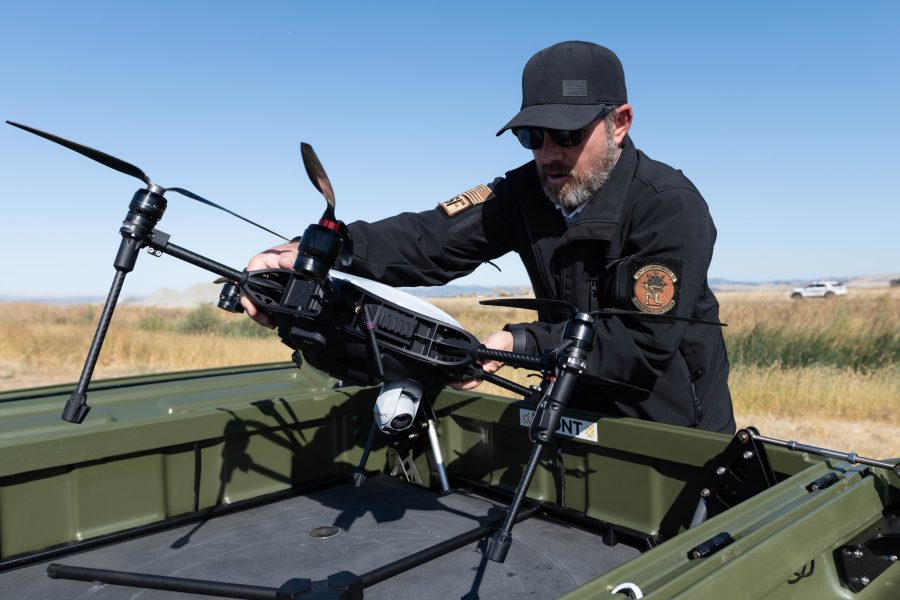NATIONAL HARBOR, Md.—To succeed in future warfare likely to feature millions of unmanned aerial systems, the Pentagon should avoid getting into a one-for-one race with China and develop a quiver of options for downing many enemy drones at one time, defense and industry officials said last week at AFA’s Air, Space & Cyber Conference.
The Air Force, along with others, has been tracking the massive impact of small, mass-produced drones on Ukraine’s fight against Russia, said Col. Jim Price, special assistant to the director of operations at Air Combat Command, focusing on preparing Airmen for aerial threats.
The small drones that have become ubiquitous in Ukraine can be difficult to track and quickly evolve to adapt to known defenses such as electronic warfare, said Price.
“Ukraine’s Operation Spiderweb highlighted the strategic implications of disregarding UAS, specifically small UAS, as a threat,” Price said, referring to the June drone strikes by Ukraine on Russian air bases. “They successfully destroyed multiple strategic aircraft deep inside of Russia. The propagation of this cheap and often untraceable technology requires generational evolution and how nations operate to address this threat—everyone from policy makers to warfighters are weighing in on the impact being made by this evolving technology.”
Industry counter-UAS experts on the panel agreed that there is “no silver bullet” for countering drones in all tactical domains. Drones-makers have learned to adapt to jamming by using multiple frequencies and fiber optic technology. High-power microwaves are effective but can cause collateral damage to cell phone networks in urban areas. Lasers have also proven effective and offer deep magazines so the cost per shot is low, but the systems can be expensive. Kinetics like missiles have worked in the Middle East but are too expensive for targeting drones that are produced at a fraction of the cost.
Most of the experts agreed the government and industry need to think differently than the one-for-one approach that has worked in the past but is likely to fail in the next conflict.
The Pentagon has launched many initiatives to counter the drone threat in recent years, yielding weapons systems ranging from hand-held Dronebusters to trailer-size high-power microwave systems like the Tactical High-power Operational Responder, or THOR.
More recently, Defense Secretary Pete Hegseth stood up a joint interagency task force in August to find ways to deliver counter-drone options for warfighters. In July, the Defense Innovation Unit selected finalists for its Replicator 2 initiative for counter-UAS systems.

That’s on top of Pentagon efforts like the original Replicator initiative to field thousands of cheap drones to counter the mass of China’s military, which experts say has the potential to create a massive drone arsenal of its own.
China is the “undisputed leader in commercial drone production,” according to a recent Center for Strategic and International Studies commentary. The Chinese company DJI Technology Company holds a 90 percent share of the U.S. commercial drone market and an 80 percent share of the global market.
The U.S. is not likely to match China in raw numbers of drones, nor should it try, said Michael Hiatt, chief technology officer at Epirus Inc.
“Let me be real clear. We can’t keep up with China on drones,” Hiatt said. Initiatives such as Replicator have come too late to outpace adversaries like China, he added.
“We just are not set up for it. … They are better at producing cheap electronics than we are. We need a different solution. We can’t do one versus one. We have to have effectors that can be effective against a significant number of drones. … That’s why you need directed energy. You need things like high-power microwave that can take out a volume of drones,” Hiatt said.
In late August, Epirus’ Leonidas high-power microwave system killed a large drone swarm with one shot, according to the company’s website.
“We took out 49 drones in less than a second,” he said. “The only reason that it was only 49 is that’s how many we bought. … We need to think differently, because one versus one is what we’ve been doing since the beginning of air defense,” he said.
Microwave may be well-suited for defending airfields in a high-intensity conflict but present a challenge when firing them in a peacetime situation at potentially hostile drones that approach U.S. bases in Europe or the United States, said Kons Muhtaris, director of counter unmanned systems at L3 Harris. The weapon’s collateral effects could very well damage civilian cell phone networks and other electronics in nearby urban areas.
“You can’t go hot in an urban environment, meaning that unless you’re in a war, you’re not going to do that,” he said. “You can’t do certain electromagnetic effects in certain areas, because it may interfere with some of these cell phones or other communications infrastructure.”
In a December 2023 incident, hostile drones flew unchecked over Langley Air Force Base, Va., prompting lawmakers and other government officials to call for better coordination with the Federal Aviation Administration to create new policies for dealing with future drone incursions over military bases.
John Theuerkauf, vice president for engineering at Frequentis Defense Inc., reiterated that call for the U.S. military to work with the FAA to find a way to manage drone traffic outside of military bases in an attempt to identify hostile drones.
“Having some on-hand traffic management capability is going to be very important because otherwise we’re going to be not knowing if the drones that are flying around are actually nefarious, rogue, maybe someone just doesn’t know what they’re doing, or is someone up to no good,” he said. “I think having that capability and that working together with the FAA is going to be very important.”
Creating large, drone-free zones around bases may be necessary to prevent another Operation Spiderweb attack on U.S. military and civilian airfields, said Jon Piatt, executive vice president for ISR, aviation and security at Sierra Nevada Corp.
“We need to have the ability to define what those keep-out zones are, because we need to be able to say, ‘if you’re operating in this area with a UAS, it’s a kill zone for either kinetic or nonkinetic—kinetic being the last resort inside of the U.S.,” Piatt said. “We’ve got to have the ability to stop them before something happens, especially when we start talking about critical infrastructure, national security assets, and base protection.”

Electronic warfare, such as jamming a drone’s radio signal, is safer than kinetic or directed energy weapons in urban areas, but newer drones now operate on a range of frequencies or fiber optic technology making them less vulnerable to such methods. Muhtaris said his company has been working on ways to quickly identify how drones are operating so they can be disabled with electronic warfare.
“You have to be able to scan that frequency. If they’re flying on RF, if they’re flying on something like fiber, you have to be able to respond to that,” he said. “You have to be able to understand what’s that drone’s weakness or the ability to address it.”
Industry also has to move quicker to get new counter-drone solutions to the government much faster than the government’s cycle of “’you tell me and I integrate or innovate, I come back to you, you test it and we continue on,” Muhtaris said. “Sometimes it’s going to have to be much more fluid in that.”
For the battlefield, kinetic weapons are effective drone killers, but the U.S. military has learned that it can’t waste expensive precision munitions on low-cost drones. Muhtaris recommended relatively low-cost, general purpose weapons such as his firm’s Advanced Precision Kill Weapons System rocket, which the U.S. Air Force has used in the Middle East to down Iranian drones.
Developing more-effective kill solutions is only half of the battle, panel members agreed. Industry as a whole should embrace an open-architecture approach that will allow the Pentagon to use a mix of common hardware and software with an assortment of counter drone weapons, said Piatt.
“An open architecture allows us to plug and play not just the kinetic but the nonkinetic solutions as well, because we have to be adaptive in a layered way that allows us to better proliferate our own offensive and defensive systems in an open architecture that doesn’t hamstring you to the original equipment manufacture,” he said. “You need to be able to field systems that other people can update, so we can take full advantage of industry technology. And especially when we’re looking at how quickly the threat is evolving—we need to allow our industry to evolve as well.”


